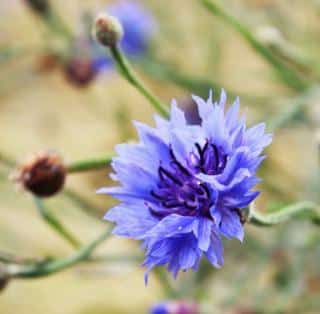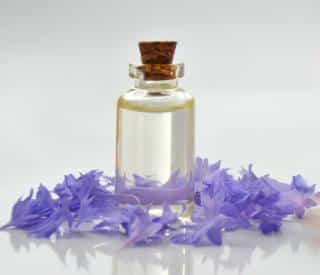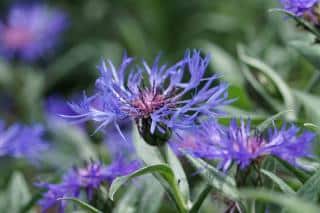

A magnificent wild plant with a clear blue flower, cornflower naturally grows in acidic garden soil, grain fields and mountainous ranges in our areas. Its flowers, both delicate and airy, make the landscape feel pristine.
Several varieties exist (purple blue, red, pink), and the blooming of cornflower is very abundant, especially in summer.
This plant native to the Middle East is known for its medicinal, culinary and cosmetic properties.
But which ailments does it treat?
Belonging to the Asteraceae family, cornflower is a plant found in Europe, North America and Asia.
A beneficial annual or sometimes biennial plant, cornflower measures 4 inches (10 cm) to 3 feet (1 meter) (depending on the variety). It grows spontaneously wherever it can, even if it prefers sun-covered areas and rocky ground.
Also called “the eyeglass breaker” (because it has a positive effect on conjunctivitis), field cornflower is under heavy pressure today because of herbicides, and it’s becoming rarer nowadays.
 Apart from its therapeutic benefits, cornflower flowers are also edible.
Apart from its therapeutic benefits, cornflower flowers are also edible.
Like the poppy for the English, cornflower took on a special meaning for French history, and the military attributions of the “French cornflower” symbolizes compassion to victims of war, orphans, widows and especially war veterans.
Indeed, in the trenches of both world wars, cornflower was one of the only plants to survive the mud and bombs.
That’s why cornflower is attached to the breast every year during memorial ceremonies on May 8th (world war II) and November 11th (world war I).
“Boutonierre flower”, “blue bonnet”, “bluecup” and “hurtsickle” are more of the many names of cornflower.
Whatever it’s called, what interests us in this article are its benefits on health.
2 different varieties belong to the Centaurea (knapweed) genus:
– Mountain cornflower or Centaurea montana (latin) to which digestive and diuretic properties are attributed.
Indeed, cornflower flowers are known to stimulate and fortify the human body, reinforcing the immune system, liver activity and easing digestion.
– Field cornflower or Centaurea cyanus (latin again), used to treat daily ailments such as mucus membrane and tissue inflammation and skin inflammation, pain and conjunctivitis.
In these cases, what is effective is its soothing activity that is beneficial for rheumatism and infections or ocular irritation (stye, conjunctivitis).
It usually appears as an ingredient in eye drops and eye lotions.
Moreover, field cornflower floral water (or cornflower herbal distillate) helps alleviate sunburns, eye irritation, and even skin disorders.
Cosmetology uses the benefits of this natural remedy first of all against dark circles around the eyes. Indeed, its anti-inflammatory properties and relaxing effect helps decongest eyes.
Its active compound thus generally is included in various products or make-up remover lotions.
As a decoction, recommended doses are cornflower herbal tea with ⅓ oz (10 g) plants for 7 fl. oz. (20 cl) water.
In an adequate container, pour the cold water, and toss in the plants. After that, on the stove, bring to boiling and then cut the heat, and let it steep for about ¼ hour, maybe 20 minutes.
Used in a mister or as a tonic for skin, cornflower hydrolate must be applied on the face in the morning (before any makeup) or in the evening (after removing makeup).
Suited to all types of skin, including the most sensitive ones, cornflower floral water used in a face mister is recommended just after any rash or redness appears. This helps firm and refresh the skin in times of harsh, hot weather.
 To treat skin rashes (acne…), cleanse and dry your skin. Follow with a cotton pad dipped in cornflower hydrolate and clean your face every evening.
To treat skin rashes (acne…), cleanse and dry your skin. Follow with a cotton pad dipped in cornflower hydrolate and clean your face every evening.
Whether to alleviate conjunctivitis, puffy, tired or irritated eyes, rheumatism or stye, simply dribble a little water over make-up removing pads (or compress) and rest them over closed eyes for a couple minutes. The impact is striking.
In the culinary arts, cornflower has also made its fame. It can be added to mixed salads or included in fruit salads for dessert.
While some use it to flavor their cakes, others delicately place them on icing to decorate, or on other dishes.
 Cornflower hydrolate is sold in pharmacies, drugstores, certain supermarkets, organic lifestlye shops and even dedicated internet websites.
Cornflower hydrolate is sold in pharmacies, drugstores, certain supermarkets, organic lifestlye shops and even dedicated internet websites.
This hydrolate is usually packaged in opaque blue-colored glass vials with the note “Centaurea cyanus“.
Once opened, to preserve and extend its properties, keep it in the refrigerator.
When in doubt, always ask to consult a specialist or your consulting physician and never exceed recommended doses.